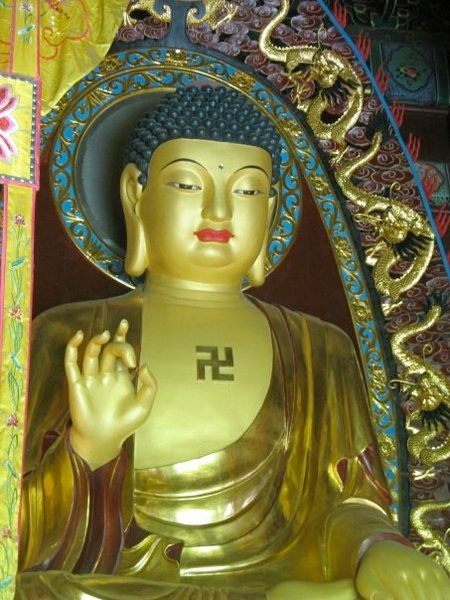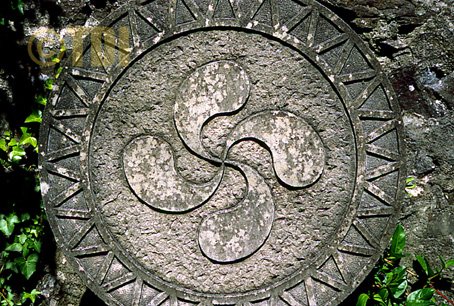The origin of the swastika
Today it is difficult to imagine a symbol with connotations as negative and sinister as those of the swastika. Popularized throughout the world by the Nazis' use of it, in Western society it is interpreted as synonymous with death, destruction, racism and totalitarianism. Although in fact the controversial symbol has a long history. It was used in a large part of cultures and civilizations, at least 5,000 years before Adolf Hitler designed the Nazi flag and always had a positive meaning, related to good luck, success, prosperity or fortune.

The word "swastika" comes from the Sanskrit (ancient Hindu language) svastika, meaning "good fortune" or "well-being." It is a sacred symbol for Hinduism, Buddhism, Jainism and Odinism. In all these religious traditions (and in many others) it still has a positive meaning. It is common to see it in temples or houses in India or Indonesia.
The symbol (not the word) of the swastika is considered to be the oldest used by mankind. The earliest and most primitive Swastikas encountered to date are those of Glozel in France, whose pieces date back to the Paleolithic period.
Its oldest meaning is associated with Solar Symbolism: The generation of universal cycles, of energy currents. The solar movement generates the movement of life, which represents the complementary forces and phases of movement, centrifugal and centripetal, aspirant and repellent, a movement that goes from the center to the periphery and returns to the center, the beginning and the end.
In Hinduism, the four arms of the swastika are related to purushartha, the four goals of the life of men, quoted in the Dharma Sastra: Dharma (religious duty), Artha (the wealth that enables pleasure to be attained) Kāma (pleasure) and Moksha (the liberation of the cycle of reincarnation). It also represents the two forms of the universe: When the arms turn to the right the swastika represents the evolution of the universe and when they turn to the left the opposite, the involution of the universe.
In Jainism the swastika is part of its official symbol, the Jain Prateek Chihna. The arms are linked to the four gati (destinies) that, according to this belief, can have the soul in successive cycles of reincarnation: human, animal, celestial and demoniac. It also symbolizes the state of one who has attained nirvana through a deep understanding of the true nature of our existence.
In the case of Buddhism, the swastika is usually depicted on the chest of some Buddha statues, and usually means "the whole" or "eternity." Also it is drawn in the entrance of temples like symbol of protection. Formerly the arms of the swastika were drawn by turning to the right, but today to differentiate it from the Nazi icon, they are drawn to the left.

On the other hand, in the Celtic culture the swastika, which is believed to date back to 10,000 BC, has been used to represent the four directions (N, S, E, O), the four elements, the four winds, and so on. It also has a funerary type symbolism, linking with the gates of birth (right-handed arms) and death (left-handed arms). It also expresses the interpenetration of two contrasting domains like the heavens and the earth. It is also the place where the roads cross (of the living and the dead, for example). All these meanings, heaven and earth, birth and death ... have opposite interpretations, but in reality can not exist without each other.
In the Basque culture they use a curvilinear variant of the swastika, the lauburu (4 heads), which represents a moving sun. The movement of the sun generates the sacred and balanced cycle of the four seasons, the four elements of nature or the forces of nature.
The vertical heads represent the feminine expressiveness (perceptual and emotional) or the elements of fire and water. The horizontal heads symbolize the masculine force (mental and physical) or the elements of earth and air. We can thus speak of a Basque pastoral symbol with values very similar to the Celts. It is nowadays a symbol of Basque culture and is widely used in ornamentation. Lauburus are carved in kutxas, cabinets, door lintels, tombs ...

The Nazis believed that the early Aryans of India were the prototype of the Aryan invaders, so they decided to adopt the swastika as a symbol of white supremacy. The Indo-Aryans were prehistoric peoples who dominated Central Asia and Eastern Europe from 4,000 to 2,000 years ago, and spoke Indo-European languages. They came from Central Asia, so it is believed that the Aryan race was not characterized by white skin and blond hair.
In any case, the design of the Nazi swastika (in black, inside a white circle on a red background) was the work of Adolf Hitler himself after receiving the suggestions of dozens of coreligionists.
It was only a quarter of a century long (during which time the Nazis made use of the swastika, between 1920 and 1945) to radically change the perception of a symbol that had been interpreted positively for thousands of years.
Reference:
Yahoo

Is central Asia the Middle East?
i think its more around India
Does India border with Pakistan or other middle East countries?
I love history as an American in Vietnam now. I told Buddhists about that symbol and said like Hitler had it. I thought at the time that they got it from Hitler. The Vietnamese did not even know what I was talking about and thought I was crazy. I had it backwards. Hitler got it from the other people.
Thanks for writing. I learn a lot.